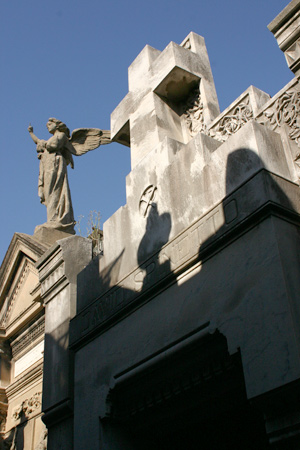
As with most European families, Argentine-born sons were often named after their father, so there are actually two David Spinettos buried here. One was born in Genoa, immigrated to Argentina, & opened the first wholesale fruit & vegetable market within the city limits of Buenos Aires in 1894. Located in the center of town, it did a booming business. David’s plaque is on the left. On his death, the Mercado Spinetto was run by his son-in-law, Juan Sanguinetti… seen on the plaque on the right.
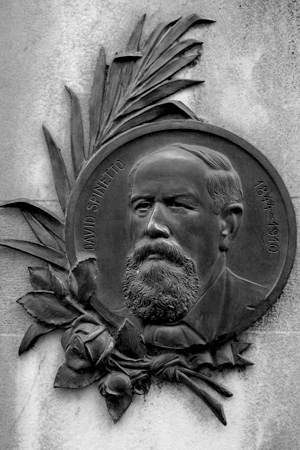
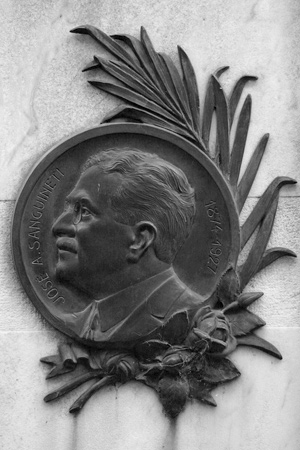
Unfortunately a wave of privatization in the 1990s shut the market down. Today only its shell remains —the interior gutted & occupied by a megachain supermarket:
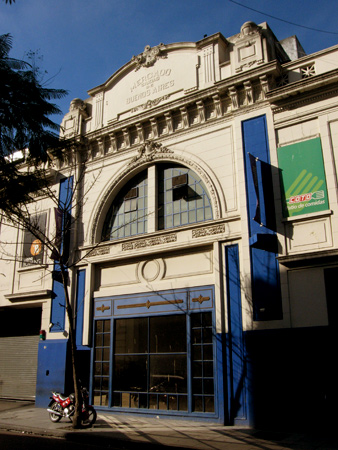
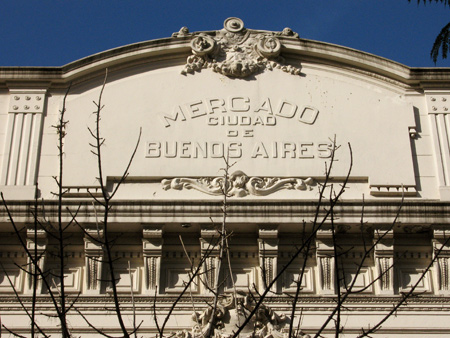
Son David, born in Argentina, left his mark as well. He became a doctor but instead of practicing, opted for administration. He ran the Hospital Italiano & dedicated his life to promoting Italian culture. It’s not surprising that this spectacular door was imported from Milan in 1912… don’t miss the inscription on the lower left corner:
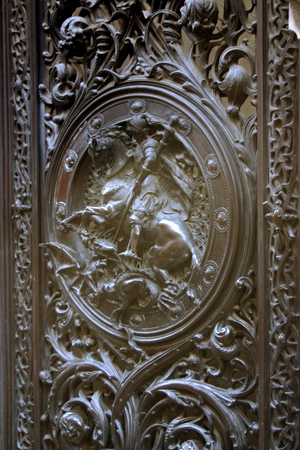
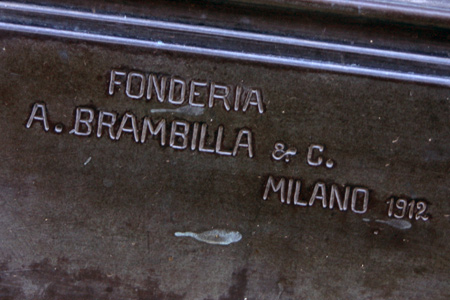
Magnificently Art Nouveau, the crown of thorns with a serpent intertwined at each corner has been turned into a decorative frame for St. George killing a dragon —a symbolic representation of the devil. St. George was a Christian soldier, born in Turkey & martyred around the year 300. As one of the patron saints of Genoa where the Spinettos hailed from, they pay a spectacular tribute to their homeland. Hands down, this gets my vote for Best Door in the entire cemetery.
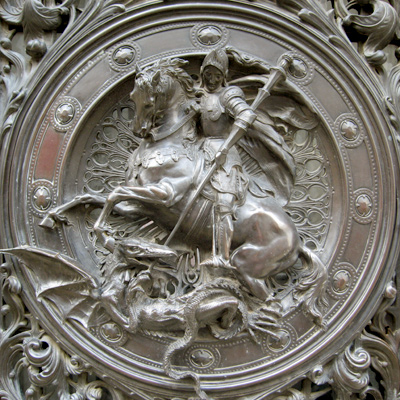
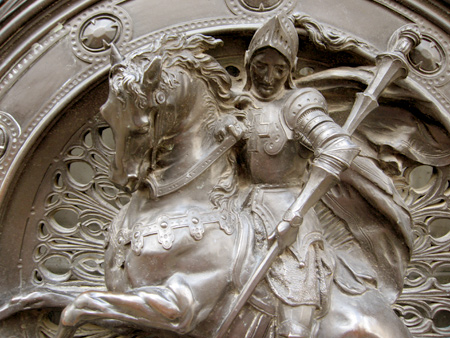
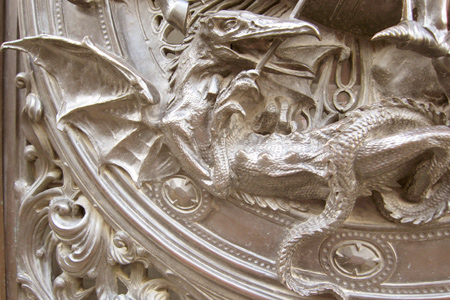
The vine design surrounding the exterior cross is repeated inside… although it’s difficult to peek through small gaps in the St. George door. Another Art Nouveau-inspired image visible is a bat just above the altar. A creature of the night, what better animal to watch over the residents of a cemetery?
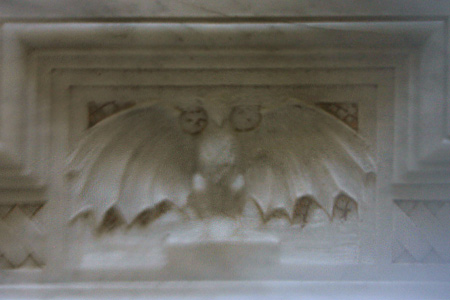
Update (25 Jul 2020): A reader from Italy (original comment below) has discovered that Milanese sculptors Carlo & Luigi Rigola designed that spectacular door for Palanti. In addition, they did the current doors for the Milan cathedral & many other works inside. An overview of their works together, including funerary sculpture, can be found on this website (in Italian). Grazie Carlo!!
Update (24 Aug 2024): An article by Pablo Chiesa published today in the newspaper La Nación adds considerable insight to the construction & design of this spectacular vault. David Spinetto left his hometown of Prati de Mezzanego at the age of 12 in 1856 to meet his half-brothers in Buenos Aires. They ran a successful sawmill —on the future site of the national Congress— and gradually began to import construction materials of high quality from Europe. The family was paid a hefty sum for surrendering the entire city block, & in 1894 David opened the Mercado Spinetto not far away.
David passed away in 1910 & his son, David Juan Luis, decided to build the vault in Recoleta Cemetery. Family letters confirm that he hired Italian architect Gaetano Moretti for the construction… but previous commitments meant he could not supervise its construction. That job went to Mario Palanti of Palacio Barolo fame.
For me, the most fascinating find of the entire investigation is the plaster model of the door in the workshop of the Rigola brothers in Cantù. How wonderful to find another piece of this historical puzzle!

Very good review! As the oldest great grandson of David Spinetoo Sr. I would like to point out that the Mercado Ciudad de Buenos Airers (Spinetto) was actually founded in 1894.
Thank you for your excellent report.
Thank you very much Angel for leaving a comment. Te puedo hacer una consulta?? Nosotros que quieren preservar el patrimonio de la ciudad vamos catalogando la obra de varios arquitectos. Como digo en la nota, hay evidencia que la puerta de la boveda de tu familia fue diseniada por Mario Palanti. Uds por casualidad tienen algo documento familiar que puede comprobar ese dato? Seria de gran ayuda. Un abrazo!
Hi Robert! First of all, please excuse my “keyboard” mistakes. I was in a hurry!
Yes, I have some letters which I will have tol ook up in my files. I am at present trying to organize them and protecting letters and other family papers in adequate files, etc. It might take a few days, perhaps a week or so to find Palanti’sc correspondence. We were eight, four brothers and four sisters. My brother Jorge passed away in 2001 at the age of 55. As you can well understand, in large families, papers, files, complete libraries,end up scattered and most times wasted. While this is not exactly our case, I do not know how careful my other brothers and sisters have been in keeping such material. I remember my grandfather David J. Spinetto had a unique book on Mario Palanti’s works and sketches, dedicated to him in longhand by Palanti himself. But I lost track of that book. Some years ago, I bought a book on Palanti with fabulous photographs, excelent binding and in premium shape. Therein is a full page picture of the vault’s door.
I seem to remember that Palanti´s relationship with my grandfather became more distant as the architect became closer and closer to Mussolini and his regime. Luckily my grandfather was a bitter anti fascist, to the point of refusing a decoration from the Italian Govt. in the twenties, because the decree was not signed by the king but by Mussolini. The Italian Republic, retributed this gesture by decorating him with the Ordine al Merito della Repubblica Italiana as Ufficiale on June 2nd, 1960. This diploma and decoration is in my posession.
Please feel free to contact me on whatever matter you may need on this subject or other related to my family or other major Italian names.With best personal regards, Angel David Pini Spinetto.
Hi Angel – I apologize for answering so slowly… I’m in Spain with a group touring around the country & am really busy with work. But I would appreciate any information you could provide about Palanti & his interaction with your family. I can understand how documents get spread out among different family members, but obviously it is very important from a patrimonio point of view. I’ll be back in BsAs in July & would love to chat for a bit. Thanks! Un abrazo, Robert
Señor Roberto:
No tengo el gusto de conocerlo, personalmente. Estudio mucho la obra de Palanti, y me he detenido a investigar su profunda iconografía de Dragones. Si tiene el libro de Prima Esposizione Personale habrá visto que es así En el Barolo aparecen dos dragones uno macho el otro hembra. En un edificio de la calle Rivadavia los usa de capiteles. También aparecen en varios proyectos no realizados. El arquitecto Palanti es de Milán. En la tumba de David Spinetto aparece San Jorge matando un dragón hembra y mamífero según la imagen por usted publicada de dicho mausoleo. Se habrá fijado que el dragón esta con su abdomen hacia arriba con la clara intención de mostrar las tetillas, por le que deduzco es hembra y no es reptil. Parece una perra que dio a luz recientemente. Me extraña mucho esa imagen. Su dualidad reptil vs. mamífero hembra. Además hace más curioso el tema que San Jorge no es el Santo Patrón de Génova, sino que es San Juan Evangelista. Por lo que creo que debía pertenecer a alguna cofradía religiosa o algo por el estilo, al igual que Palanti. Como veo que usted tiene contacto con la familia me gustaría saber si usted puede resolver esta curiosidad. Desde ya muy agradecido, Carlos Hilger
También sirve el: hilger@ciudad.com.ar
Hola Carlos –
Gracias por el comentario. Conozco el Palacio Barolo bien y muchos de los edificios que Palanti construyó aca en Capital y sí, sin duda, le gustaba usar la imagen del dragon para decorar. Pero lo que ves en la puerta como una mezcla de dos animales, no creo que Palanti queria dar esa idea. Si buscas en internet imagenes de San Jorge y el dragon, algunas tienen algo tipo garras justo abajo del cuello largo. Por ejemplo:
Supongo que con tantas representaciones de esa escena mítica, Palanti eligió una así para usar en la puerta. Bueno, es mi hipótesis. Dudo que la familia sepa algo al respeto pero si encuentro el mail de Ángel, le pregunto.
San Jorge es uno de los tantos santos patrones de Génova. Fijáte en Wikipedia… los genoveses, con su flota mercantil, son responsables de tanta difusión del santo en Europa. Saludos!
Hola Angel,
cómo puedo contactarlo para hacerle una entrevista?
Hola, necesito contactarme con Ángel David Spinetto Pini para hacerle una nota, sobre David Spinetto, muchas gracias!
Hi Angel, as a fellow descendant of David Spinetto and family, I would love to get in contact with you. I’m doing a large genealogy project and am trying to connect my great-great grandfather, Esteban Spinetto, who immigrated to Bs As in 1849 from Genoa to your David. I am struggling to determine if they were brothers, nephews, or something else. Please let me know if there’s a way I could get in contact with you!
Hi Angel, I would like to contact you to have more info on Mario Palanti and on the image of S.George’s door.
My name is Carlo and I’m researching connections between Mario Palanti and an Italian sculptor that already worked with his brother.
Thank you,
Carlo
Hola Angel. Mi bisabuelo Juan Raimundo Spinetto es hijo de Bartolomé Placido Spinetto que vino de Génova también. Estoy armando el árbol genealógico y quiero saber el parentesco, que sé con seguridad que tienen pero se cual es.
Te agradezco si me contactas por favor
Hola Marina, cómo estás?
Mi abuela era María Irene Sanguineti Spinetto, hija de María Rosa Spinetto que era hija de María Irene Spinetto a su vez hija de David Spinetto y María Costa. Me gustaría saber si tenés algún estudio hecho sobre la genealogía para poder empezar a investigar un poco mis antepasados. Saludos y gracias!
Buongiorno Angelo. Il nonno di mia moglie è lo scultore che ha modellato la porta bronzea con San Giorgio della edicola David Spinetto alla Recoleta. Sono gli scultori Carlo e Luigi Rigola di Milano che hanno modellato nel gesso il portale. Abbiamo cercato con le informazioni che abbiamo, di ricostruire la conoscenza con Palanti. Magari hai informazioni storiche anche sul portale. Grazie
Carlo
Buongiorno Carlo. Grazie per le informazioni sugli scultori della porta! Lo aggiungerò al post sopra. Puoi dirci se hanno lavorato con Palanti su qualsiasi altro progetto?
hanno lavorato con il fratello di Mario, Giuseppe Palanti.
Nel 1906 hanno modellato un gruppo scultoreo alto 3,5 metri per l’Expo di Milano 1906 partendo da un disegno di Palanti. E’ stato realizzato in ceramica dalle ceramiche Faentine, ma andò distrutto nell’incendio del padiglione delle arti decorative durante expo!!!! Poichè hanno lavorato con entrambi i fratelli, può darsi abbiano fatto altre opere, ma non ho documenti. Ho immagini, gessi, ma non sappiamo di alcuni dove possano essere. Mario Palanti ha fatto altre tombe in Recoleta?? Noi abbiamo il gesso del portale con San Giorgio! se hai informazioni teniamoci in contatto.
http://www.carloeluigirigola.it
Ciao
Carlo
Che meraviglia che tu abbia ancora il gesso del portale! Mario Palanti potrebbe aver progettato una tomba nel Cimitero di Recoleta: http://www.recoletacemetery.com/?p=336 Ma nessuno ne è certo. Un altro link di interesse: http://mariopalanti.blogspot.com/search/label/Cementerio%20de%20la%20Recoleta
Sarebbe possibile ottenere una copia del libro che mostri sul tuo sito web? Vivo a Siviglia, quindi inviare il libro per posta sarebbe facile. Grazie e per favore rimani in contatto
per il brutto momento del covid, il libro è stato presentato ma non abbiamo ancora stampato le copie. Quando le avrò fisicamente ci aggiorniamo
Carlo
Grazie mille Carlo. Stiamo vivendo un momento difficile anche in Spagna con COVID-19. Alcuni giorni penso che questo non finirà mai. Rimanga sicuro.